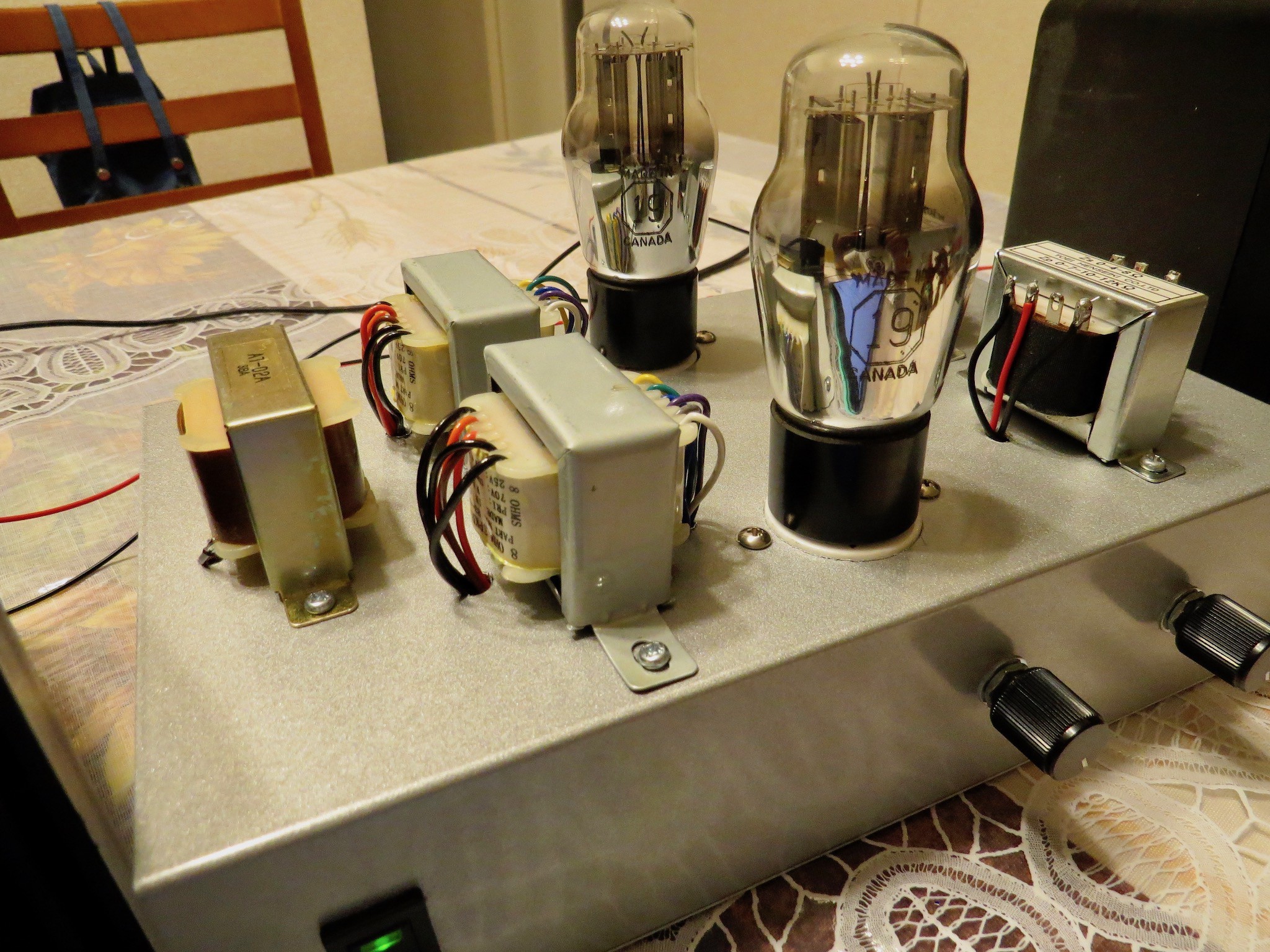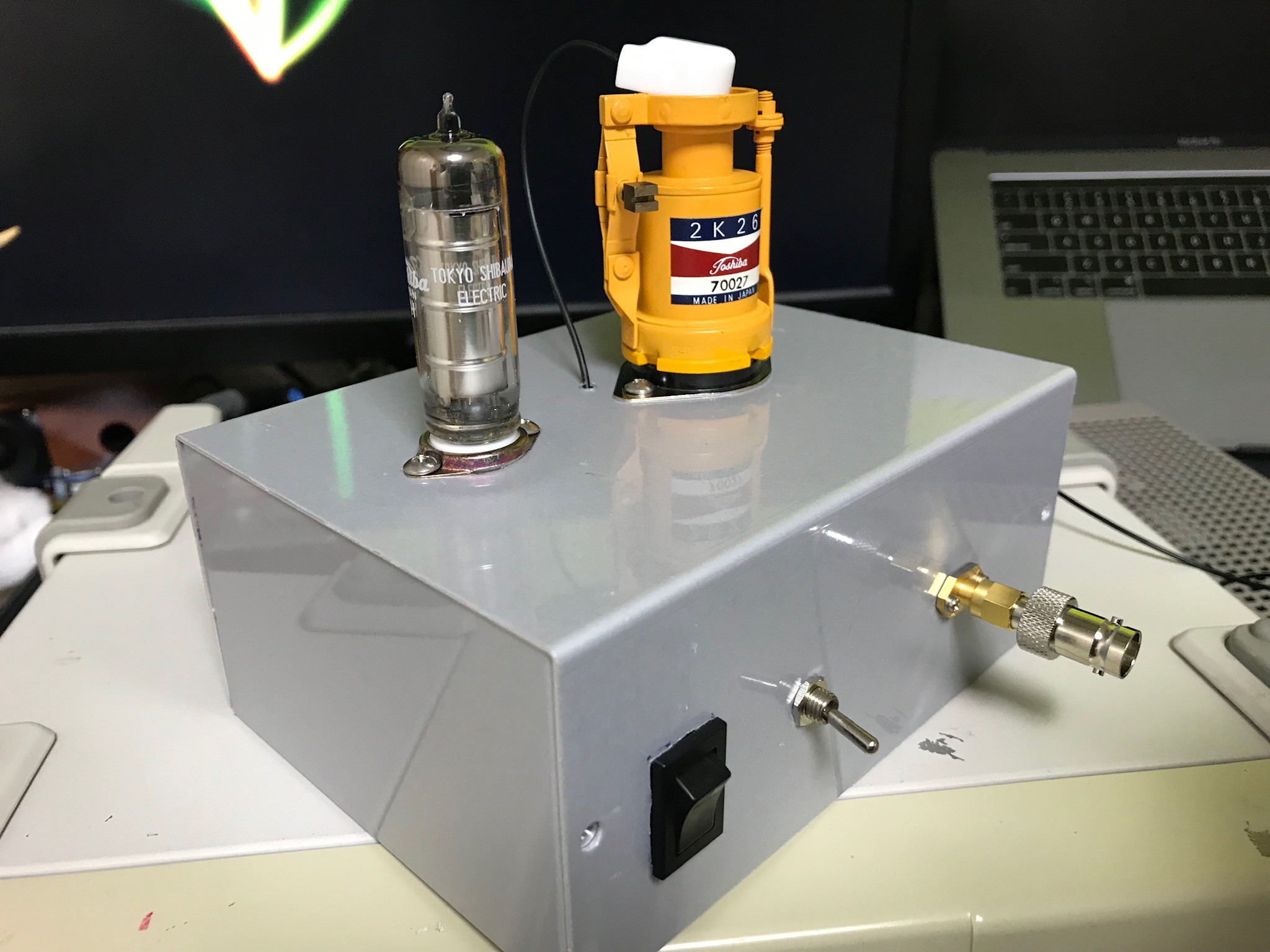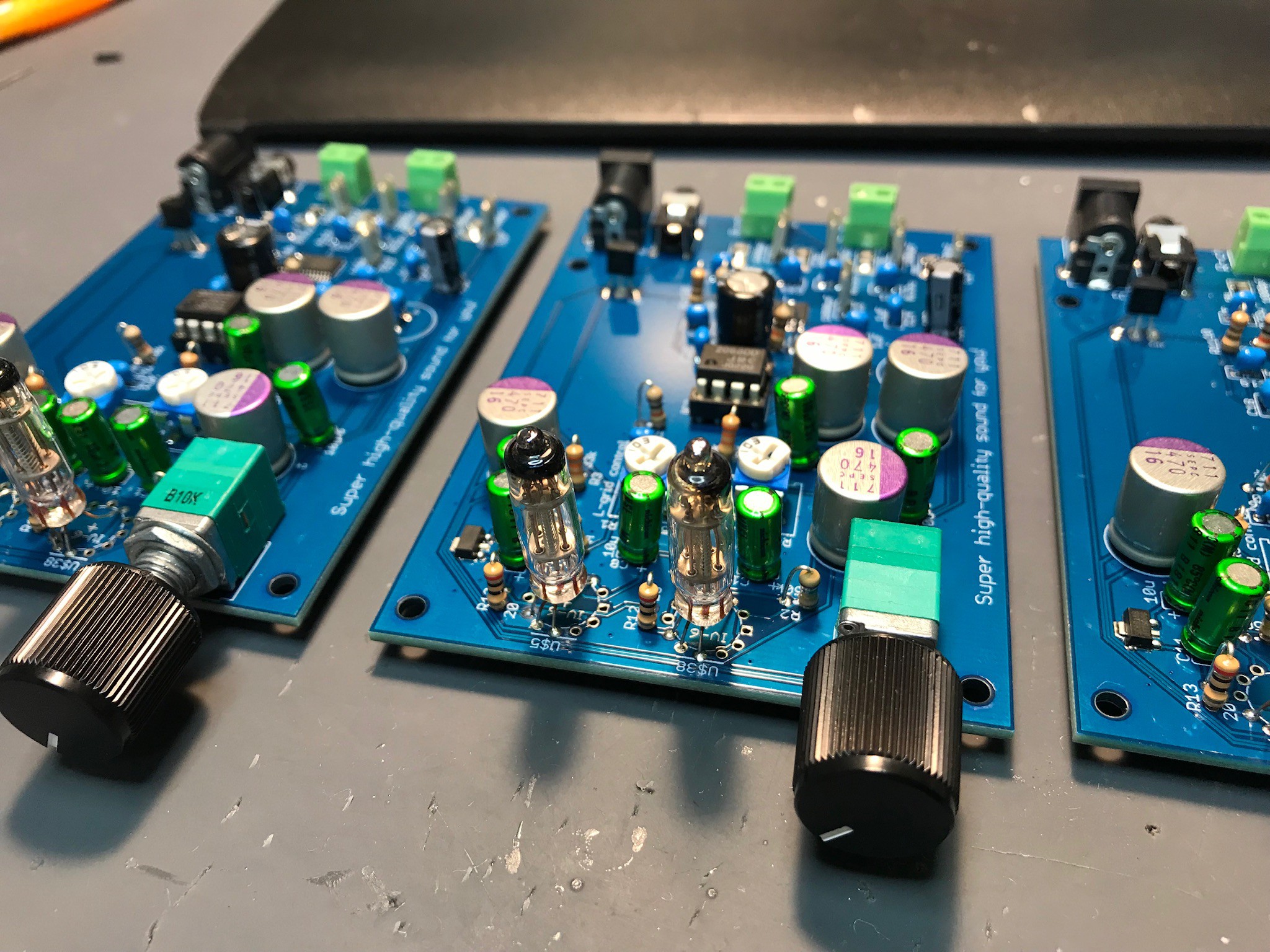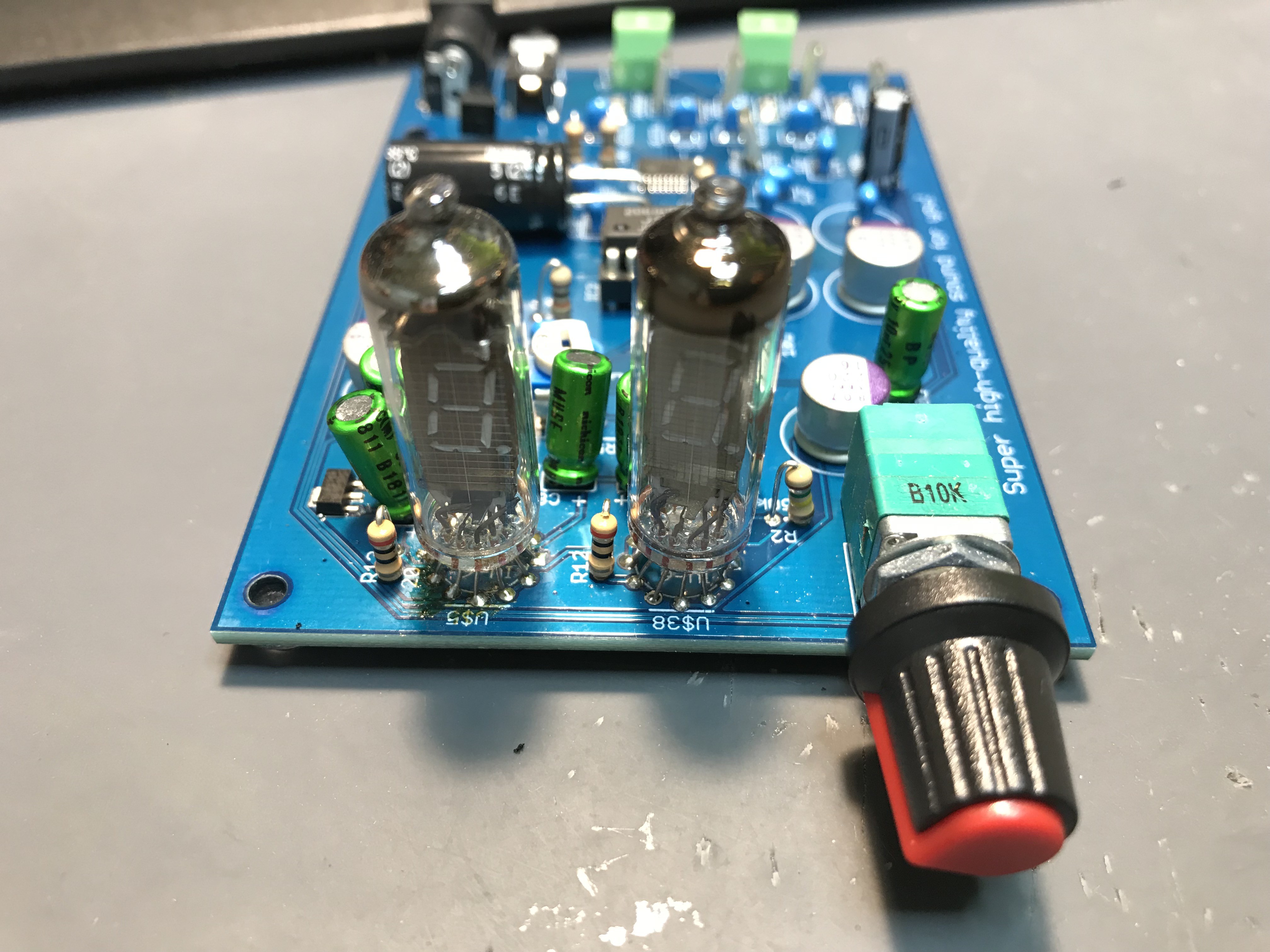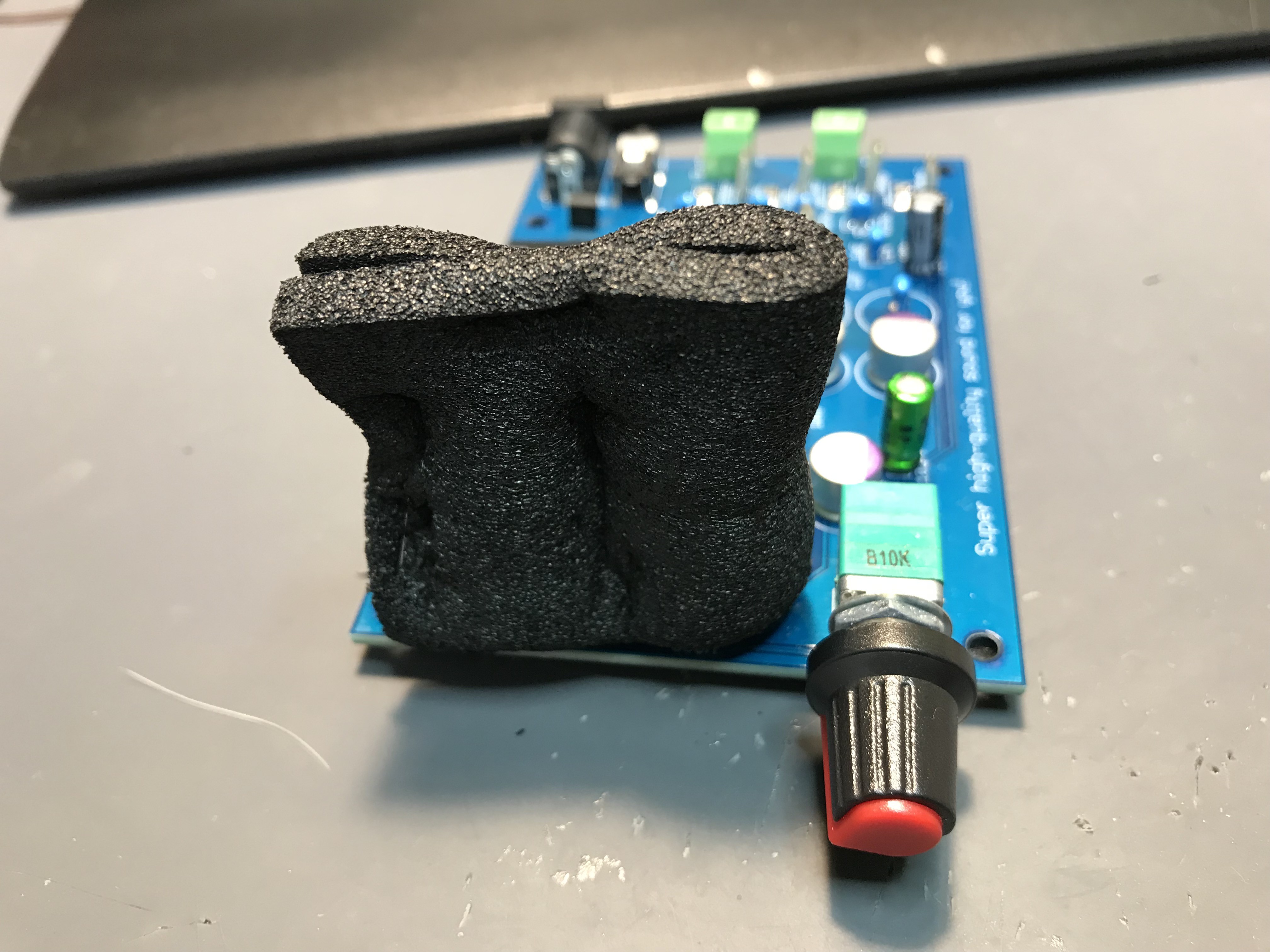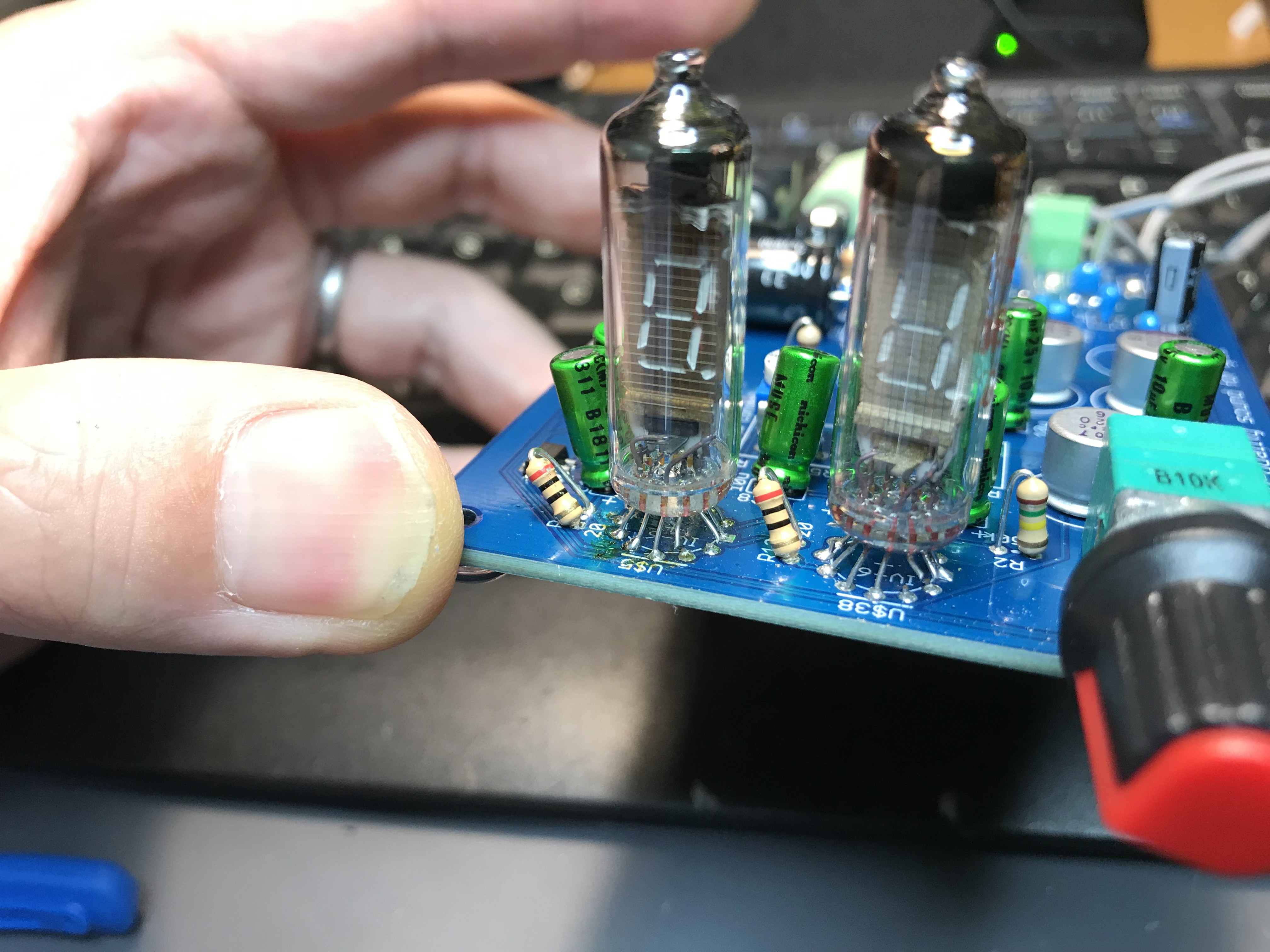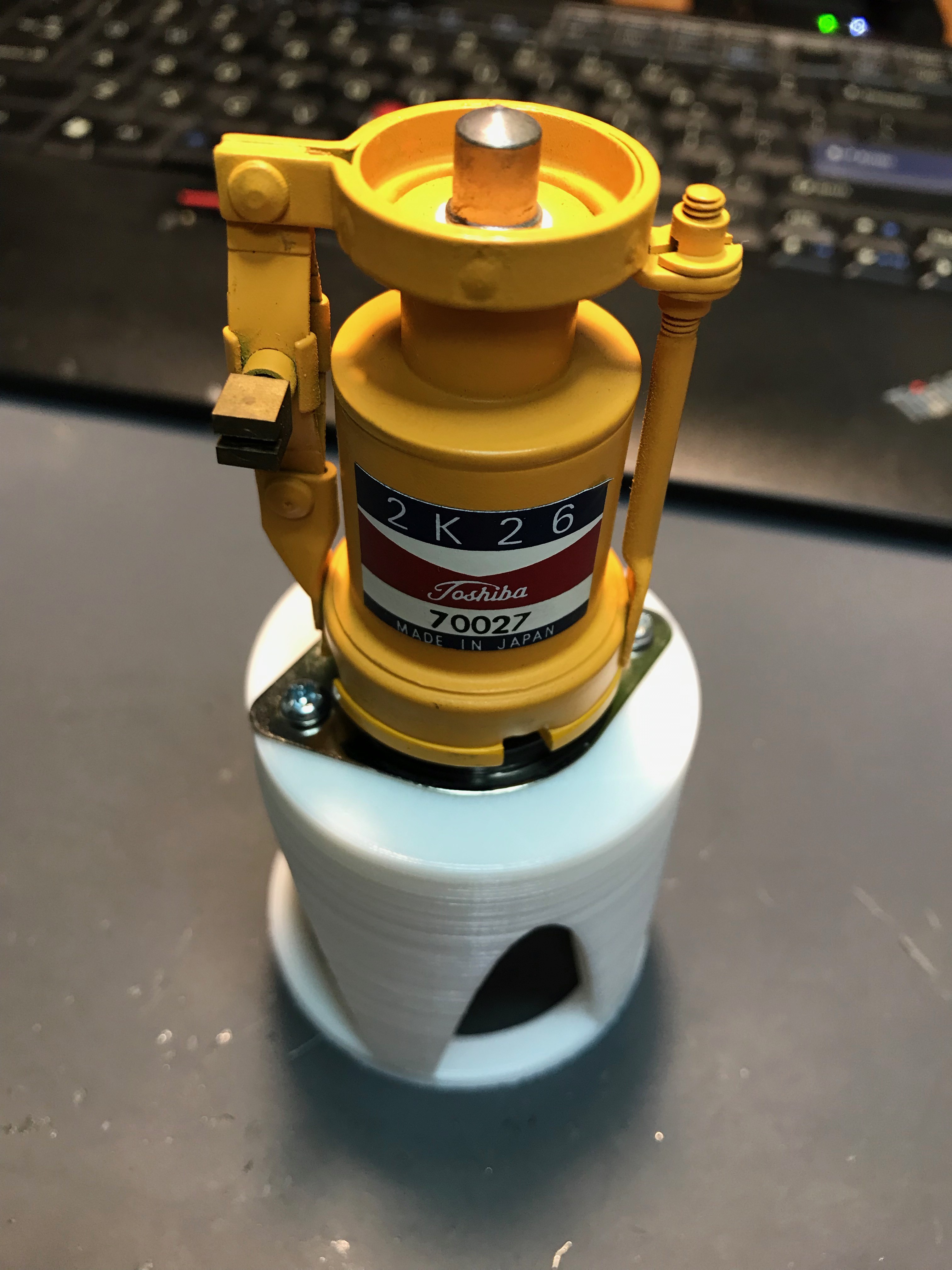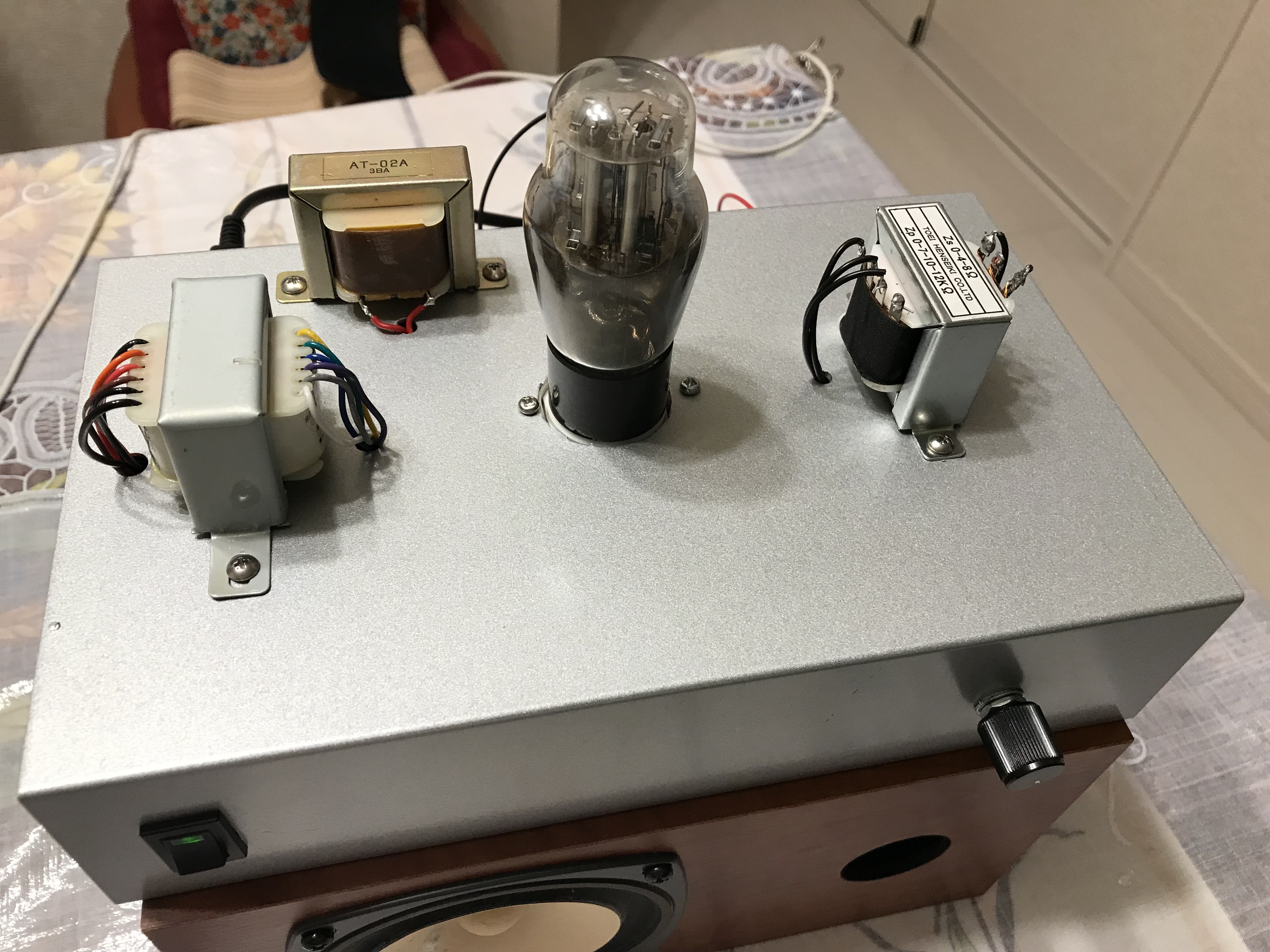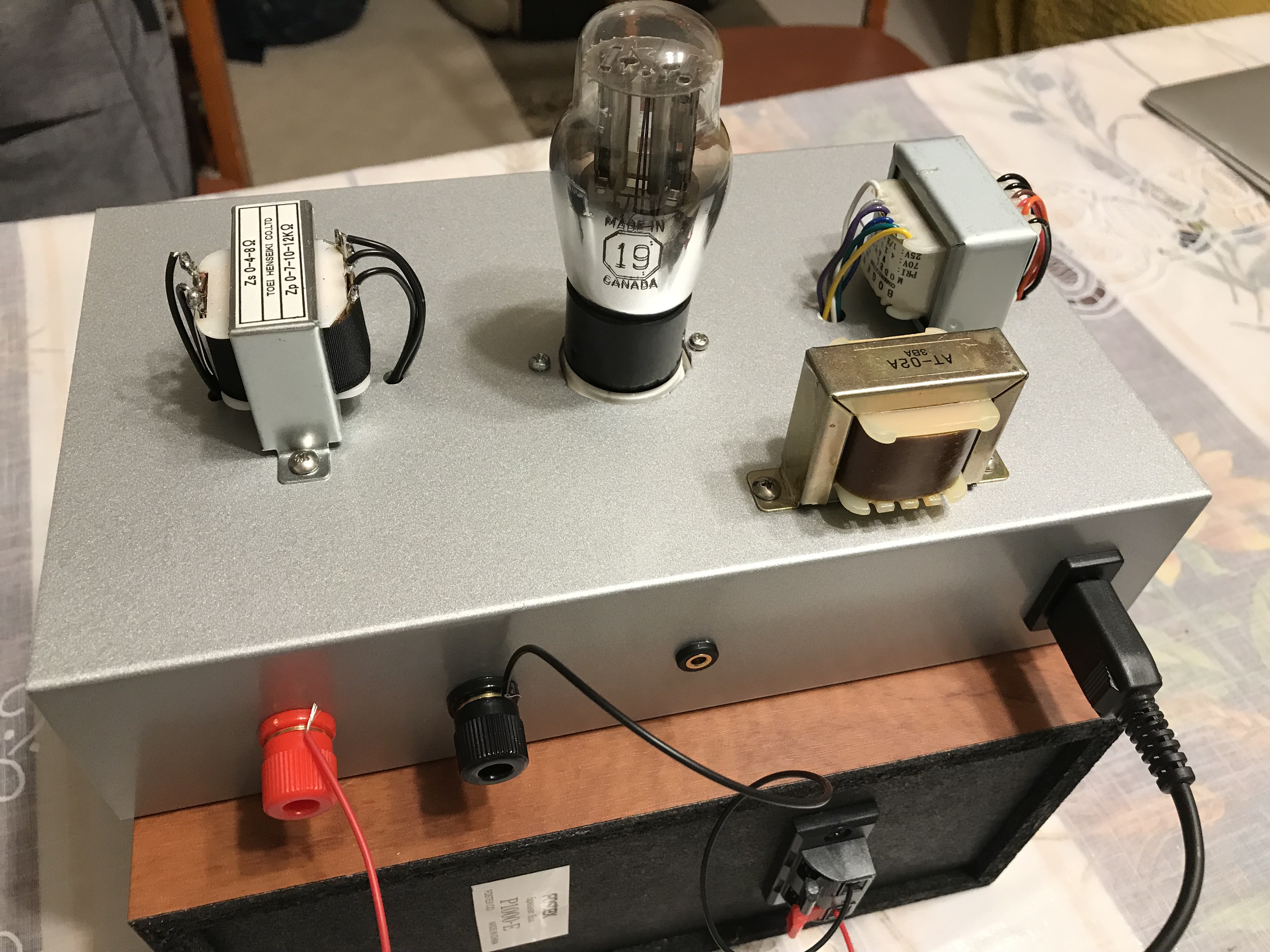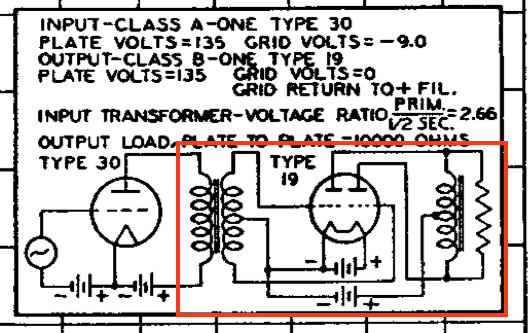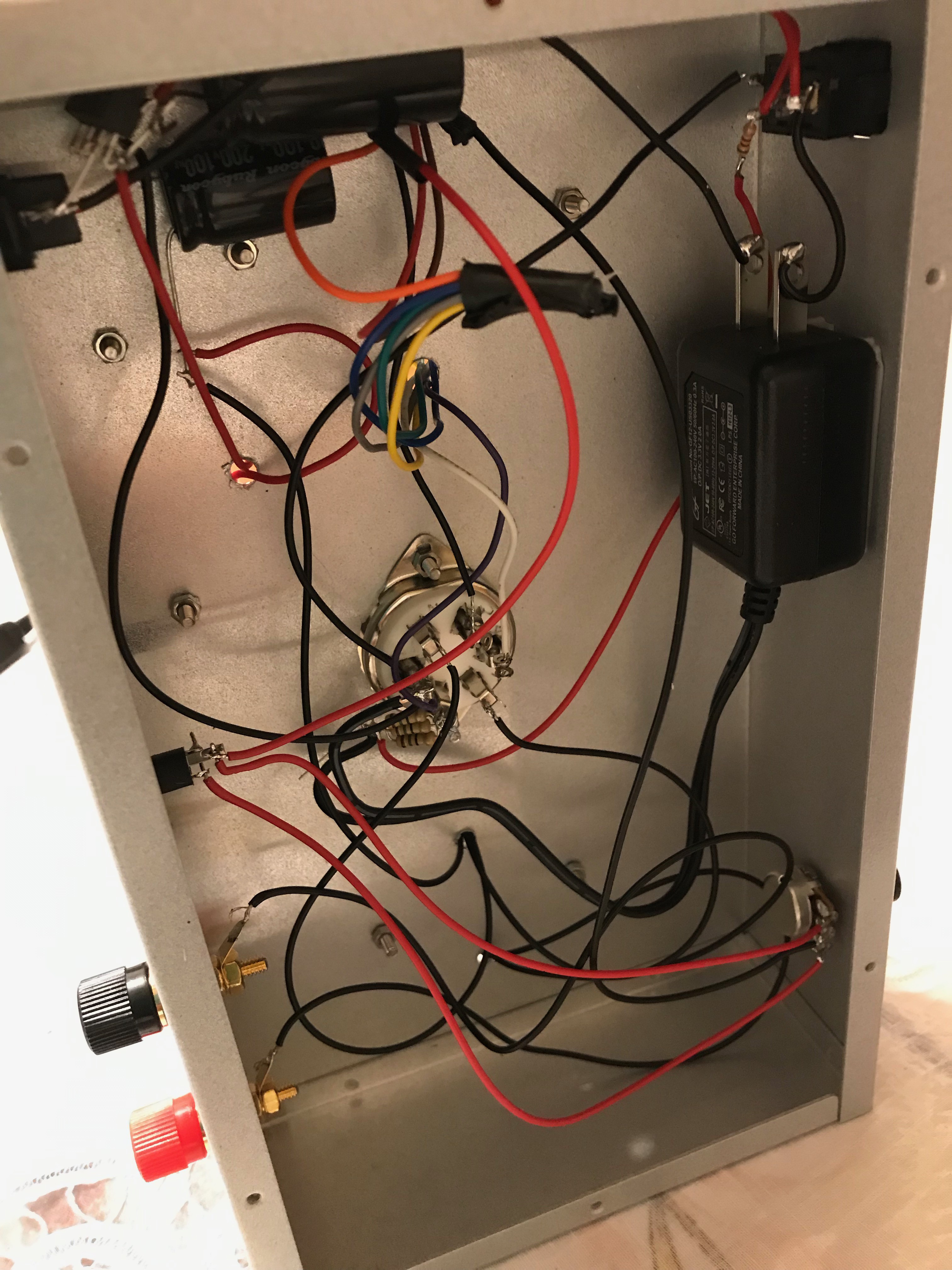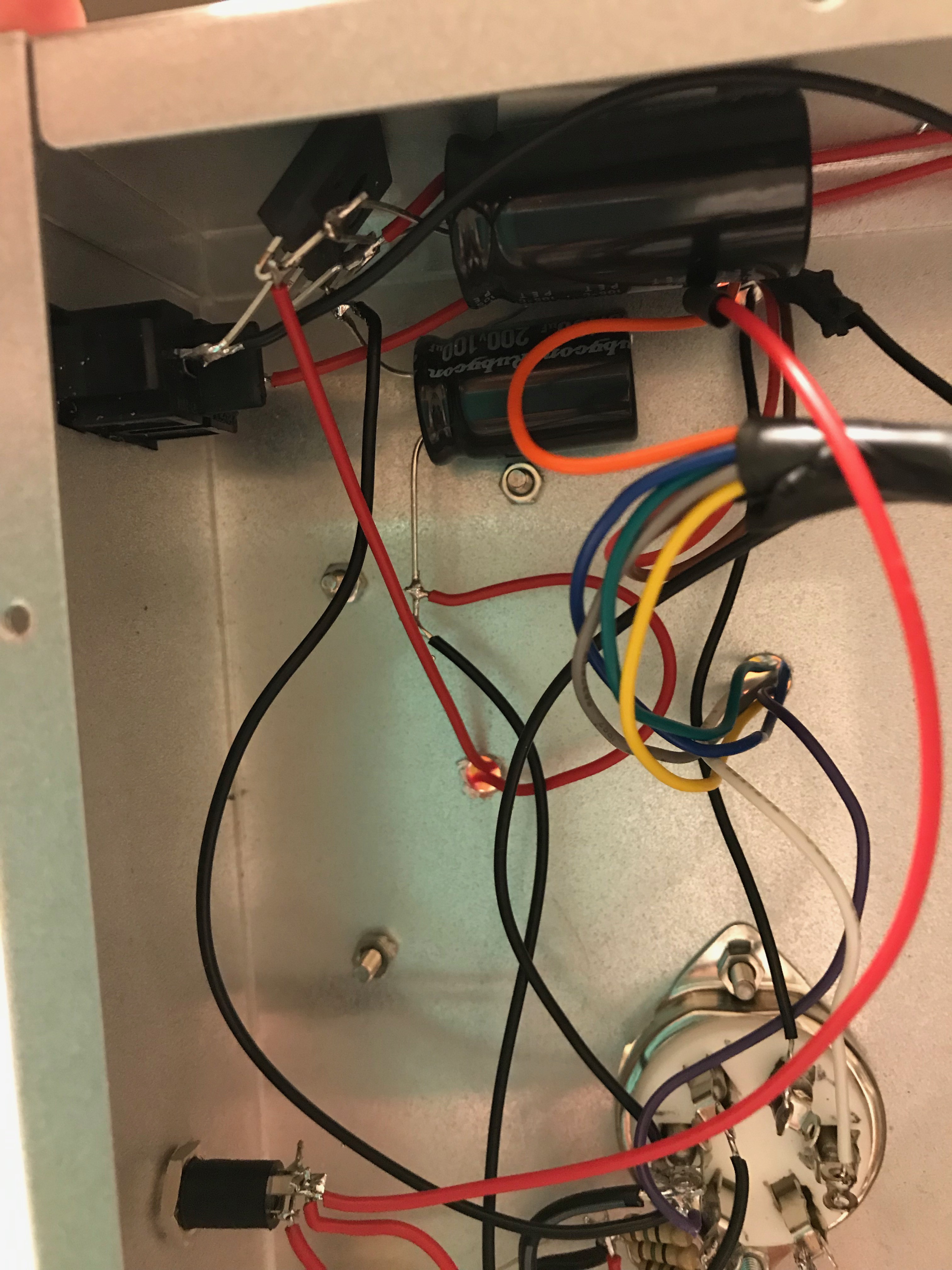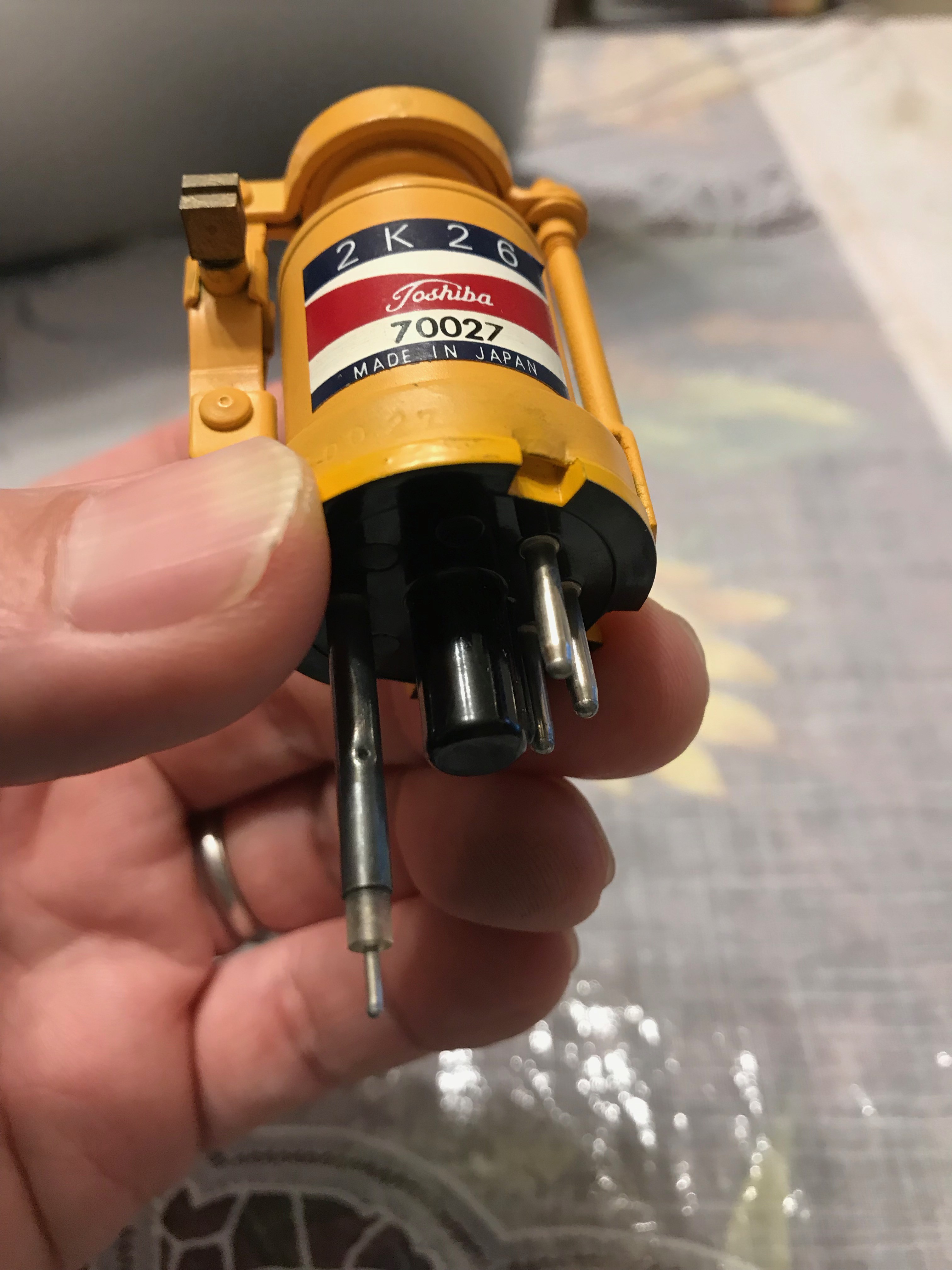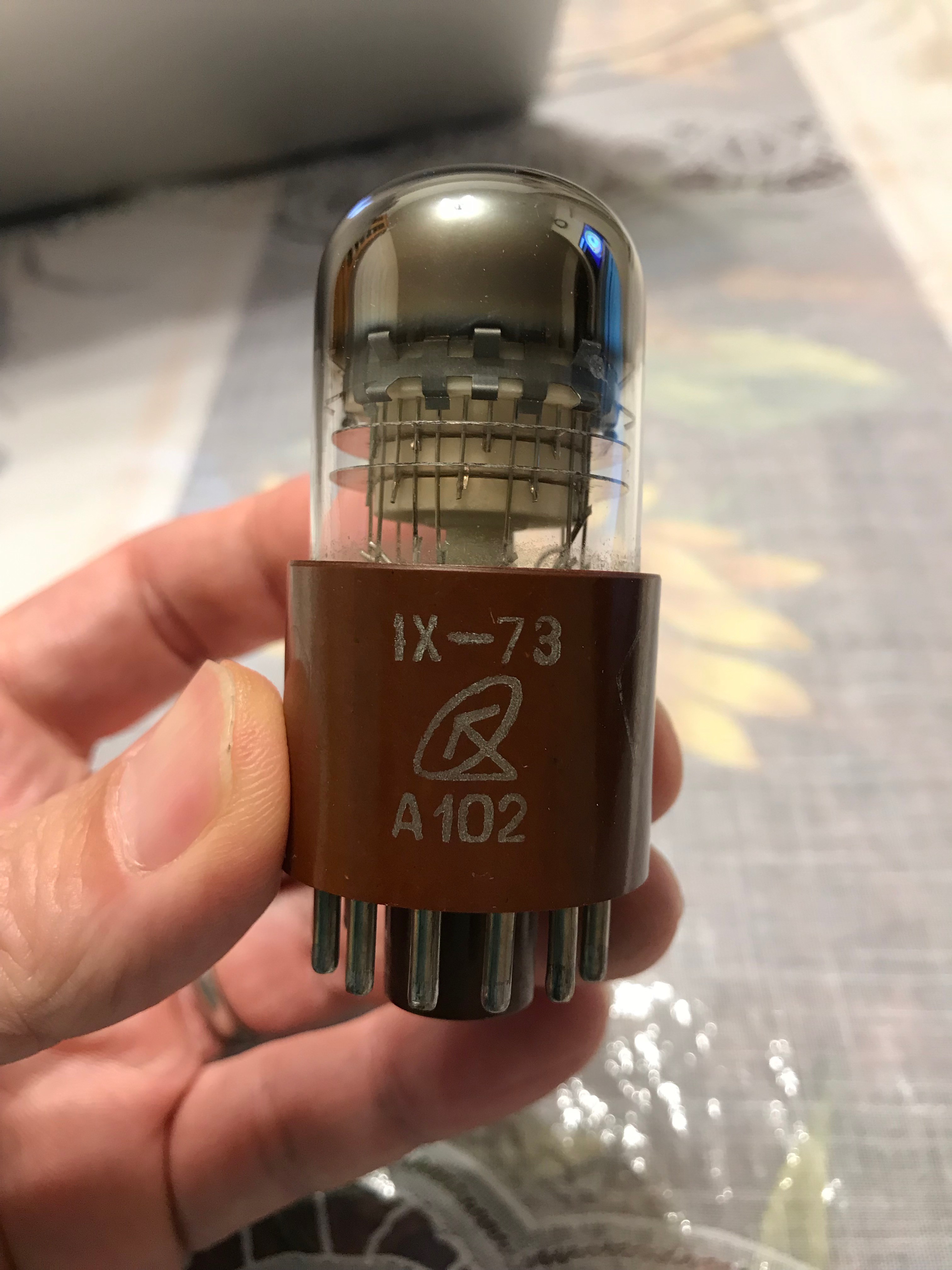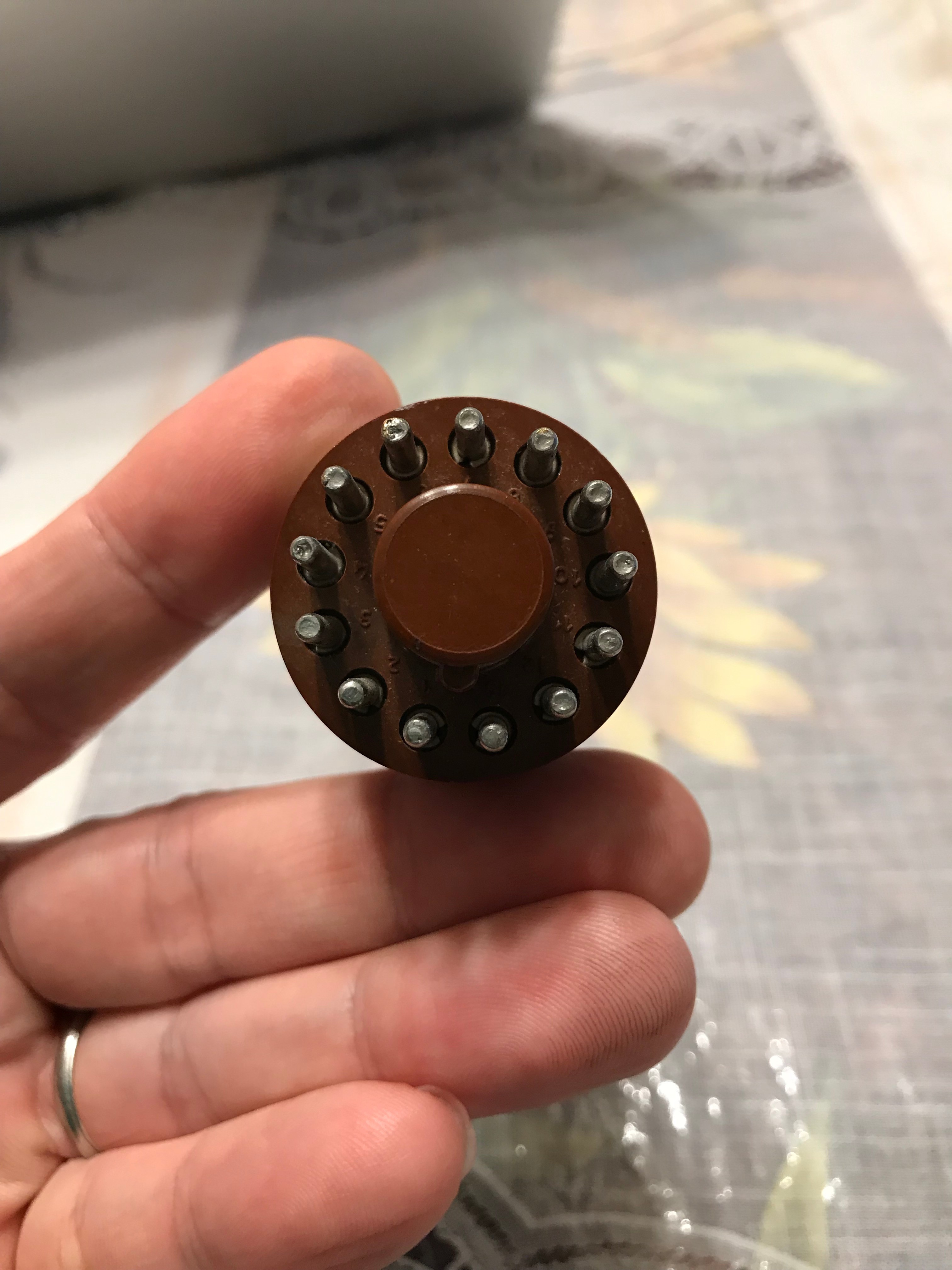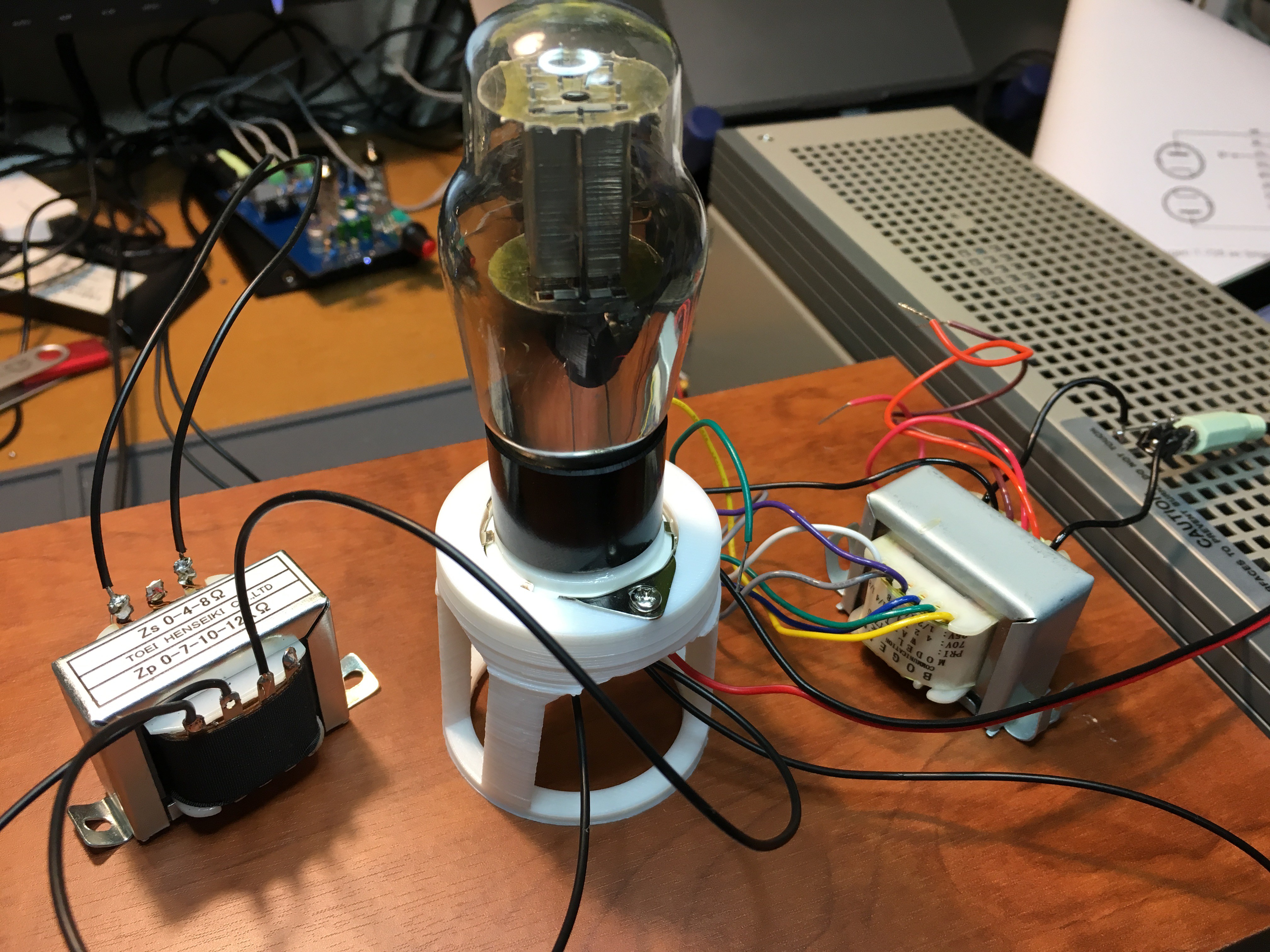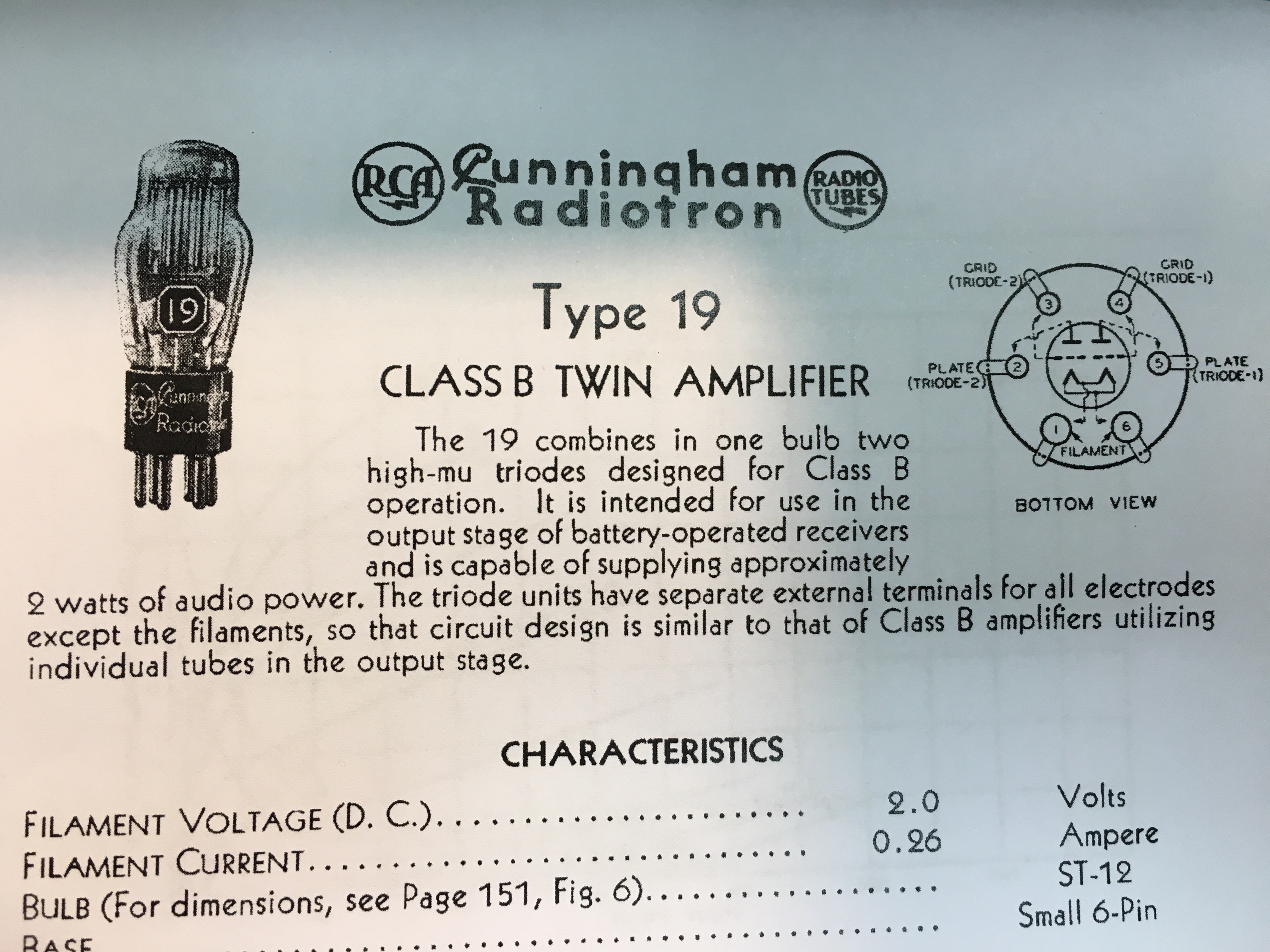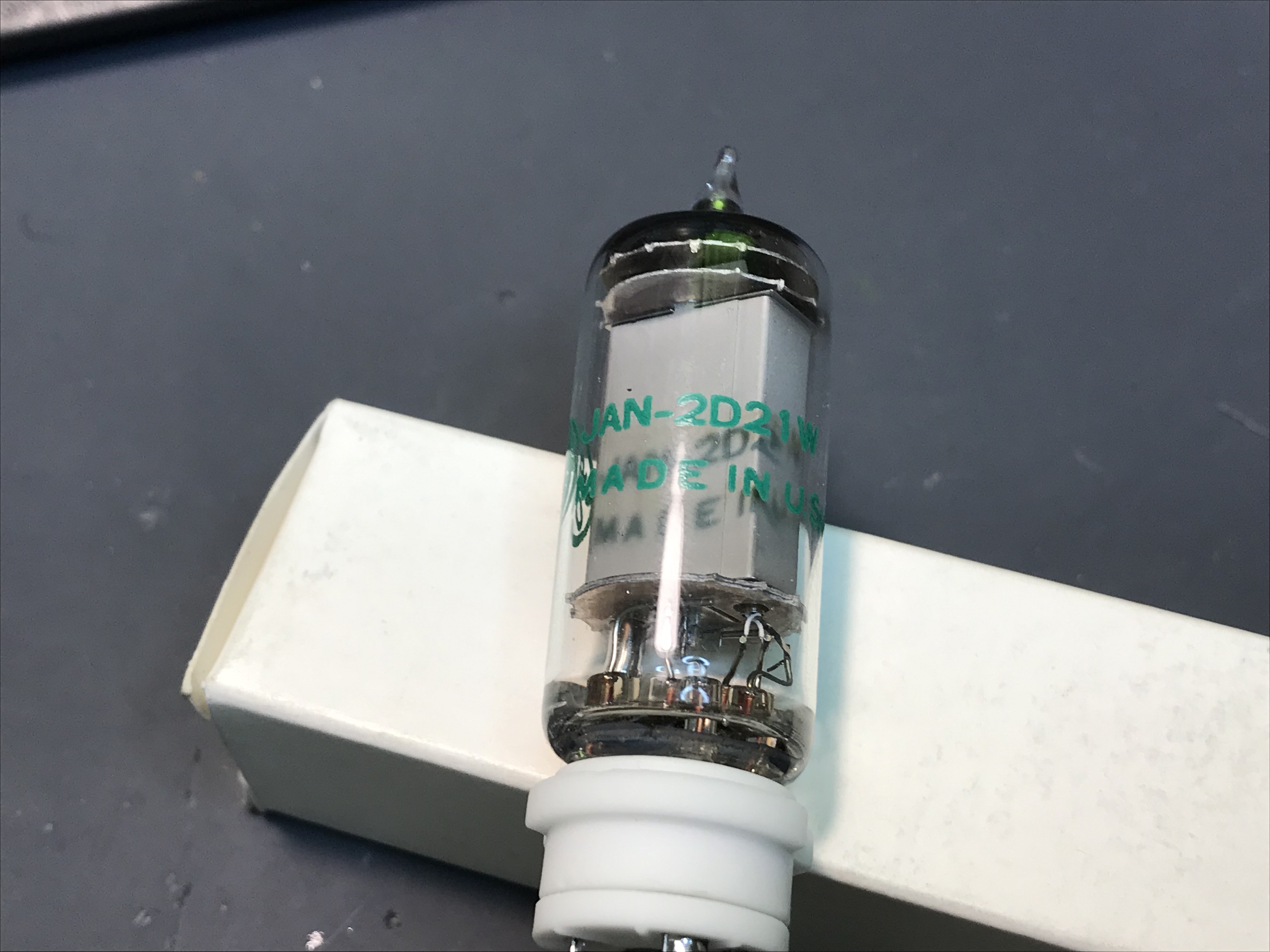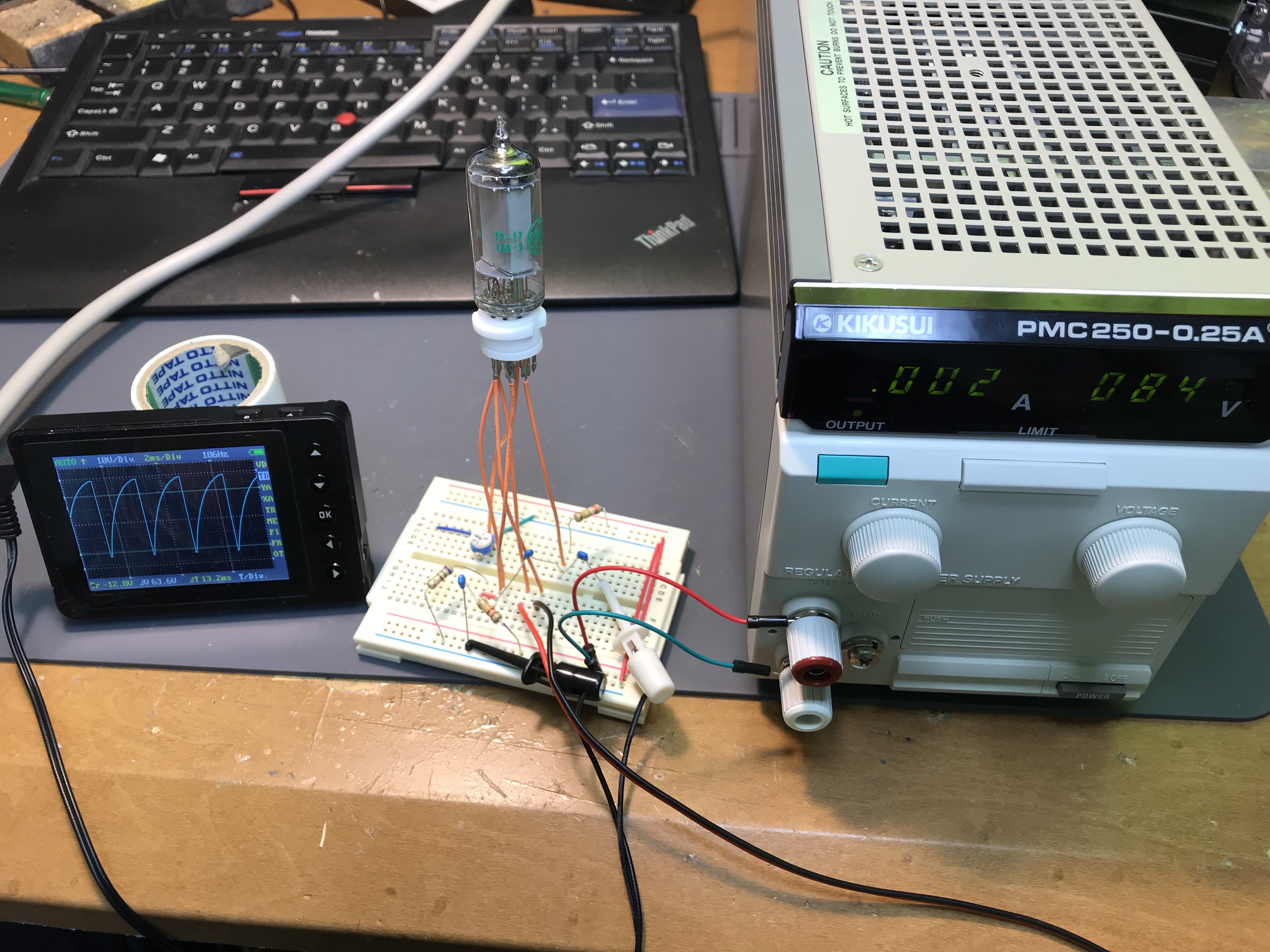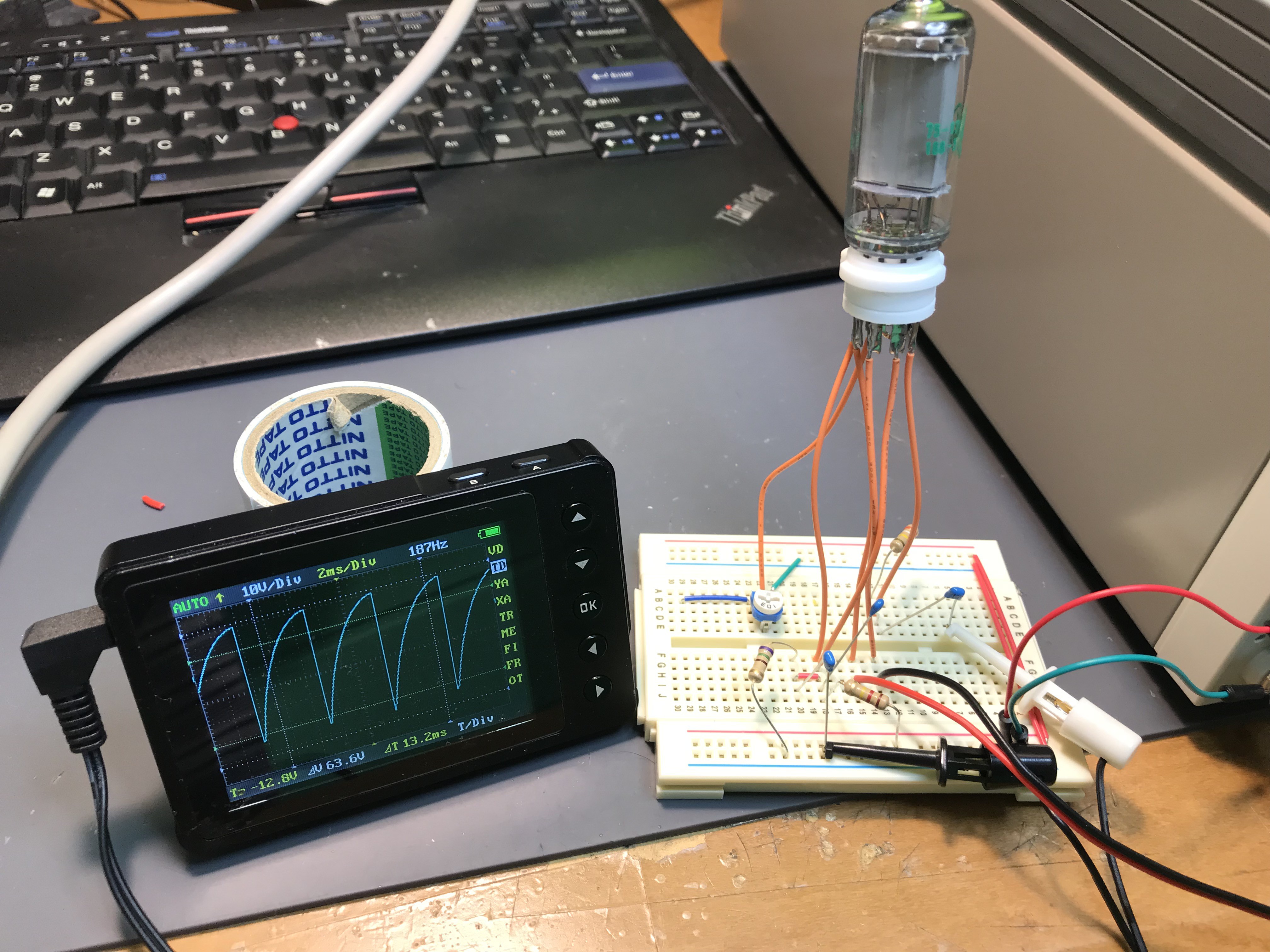-
1930's classic ST tube plays wonderful stereo sound!
07/16/2019 at 09:28 • 0 comments![]()
Previously I've presented mono power amplifier using classic ST tube, type 19. Indeed I was so fascinated its wonderful sound (far wonderful than I expected), and this time I made two channel, stereo power amplifier. Basically the circuit is the same as before, just repeating twice. Its heater voltage is generated by switching regulator (tiny AC/DC adaptor), and plate voltage is generated just rectifying AC100V. So no power transformer but just one choke coil. You can see the rest 4-transformers, the input trans is BOGEN T725 between white-violet-black and violet is used for centre tap for tubes. The output trans is tiny 0-7-12k to 8 ohm, it is apparently not centre tap but it is working. (not ideal operation, but working well).
Actual operation can be found in the following movie... Have fun!
-
Klystron is working!
07/11/2019 at 09:22 • 0 commentsThis is the first trial for me to get microwave oscillation of Klystron. The klystron tube requires three voltage, heater, resonator, and reflector. Heater voltage is simply generated by switching AC/DC, and -105V reflector voltage is generated by VR105-MT voltage regulator tube (in the following movie, I am saying -75 V, but the correct one is -105V DC) through just rectifying AC100V to DC, and resonator voltage is generated by external DC power supply. As you see, YES it is working!
-
I gave up 7-seg VFD but completed by another VFD!
07/10/2019 at 12:02 • 2 commentsAs presented in my previous log, I've tried audio amplifier implementation, and after prototyping I moved to "tiny production" for tindie. HOWEVER, tight soldering to PCB (prototyping stage, it was tentative) leads to un-solvable ultra strong microphonic making ultra loud howling through speaker-tube feedback. I've tried several material attachment to VFD to reduce feedback, but sometimes it is succeeded but another day it goes super howling. Eventually I gave up this game. The 7-seg VFD does not have any responsibility because they are made for "digit display". Fortunately I have another VFD display, DM160. It is not segment one but its "audio application" is far stable and reliable, and also characteristic variation is very small between devices. So I changed tube from 7-seg to DM160.
Actual operation is presented in the following movie. One additional function of this new amplifier is "power-on speaker pop canceling". You will see "zero pop" for power on in the following movie..
-
7-seg VFD based audio amplifier is done!
07/06/2019 at 11:40 • 2 commentsAs presented before, I've confirmed 7-seg VFD can work as triode for audio application. But the previous case was just prototyping and indeed PCB was the one of Nutube.
![]()
This time I designed a PCB especially for VFD. It looks like showing some digit but it does not but amplify the audio signal for left and right channel.
![]()
However, I encounter ultra strong howling, consisting of feedback loop from speaker to microphonic. Therefore I have to put "soundproof sponge" on VFD in order to cut this troublesome feedback. By putting this sponge, howling can be suspended, but the looks is not so good (something black item on PCB...)
Actual operation can be found in the following movie...
And after taking movie, I completed the fix by de-activate three segment of VFD as the image below. The issue is too much gain of VFD (can you believe VFD has too much gain?, but true..).
![]()
-
Small update for Klystron
07/06/2019 at 11:15 • 0 commentsAs my personal interest, I want to oscillate the klystron. Definitely I need socket for experiment, but its socket is quite rare (it is natural since no one use such a small size klystron nowadays.). So this time I made socket by octal-GT tube socket.
![]()
Just socket is still fragile for experiment, so also its stand is made by 3D printer.
![]()
Just a little step forward now...
-
1930's ancient vacuum tube power amplifier is done!
07/04/2019 at 12:12 • 2 commentsBy good chance, I made a audio push-pull power amplifier with very nice sound quality. But the previous implementation was done with external regulated DC power supply and of course it is not so handy. So this time I made the amp just in one enclosure with power supply.
![]()
![]()
As you see, one transformer is added. Actually it is not transformer but choke coil for power supply (gigantic 22H).
![]()
The schematic is exactly the same as in the reference circuit in the data sheet. I don't have exact center-tapped transformer for push-pull operation, so substituted 0-7-12 k transformer for output and input is Bogen T725 with white-violet-black. YES, it is zero capacitor nor resistor circuit.
I don't want to show the inside, because...
![]()
It is too dirty. (I would say in advance, I am not pious audio maniac...) In order to get heater voltage (2.0V), I just put tiny 3.3V switching power supply and 2.0V is obtained through ohmic resistor voltage drop. The plate voltage (around 130V) is obtained just rectifying 100V AC, through capacitor-inductor network.
![]()
This is the first time in my life to use 400V tolerance capacitor. I know it is not clean and never be some good example, but it is working well!
Actual operation can be found in the following movie...
-
Still another vacuum tube to come
07/03/2019 at 11:06 • 5 commentsStill I got a new "unknown" tubes for me.
The first one is klystron (more strictly, reflex klystron), an electron tube that generates or amplifies microwaves by velocity modulation.
![]()
I've known it only by text book, but have not got the real one. This time I got just around 500JPY. One mystery for me was "long electrode".
![]()
YES, it's semi semi-rigid cable. Originally it was connected to coaxial-waveguide transducer (just stick to rectangular waveguide with considering impedance matching.), but I will directly connect to female SMA later. The issue is voltage requirement. Oscillation requires 300V, 60V, and heater 6V... Hmmmmmmm.
![]()
The second one is, "dekatron". It is a counter device and can maintain its data during power-on.
![]()
Hmmmmmmmm tooooo much pins of 13. It is unique socket and it may be available but more expensive than the tube price (it is 300JPY).
To be continued...
-
Audio power amplifier by "19", direct heated twin triode
06/30/2019 at 12:32 • 2 commentsBefore I've got it by a very low price but its style is luxurious ST tube, named "19". It is 1930's direct heated twin triode and I guess it is not so popular for audio maniacs (guessing from its price.)
Its datasheet says "class B twin amplifier" not "vacuum tube" or "direct heated twin triode" and the purpose of this tube was strictly specified for "push-pull".
So I quickly made push-pull power amplifier by just three components, tube and input and output transformers. Each of trans was just available one and this amp does not have any clever design, just connecting! (as the data sheet says, this tube may be class-B amplifier by its nature..)
Actual operation can be found in the following movie. Indeed, its sound is very nice!!
-
Thyratron experiment
06/26/2019 at 05:35 • 1 comment![]()
I am pure "communication system engineering" person and I have no experience thyristor, a high power semiconductor electronics device. Now we can find "thyratron" by very low price at shop because mostly vacuum tube price is supported by audio maniacs. I found 2D21 by 100JPY at vacuum tube store and this time I will try to examine how it works..
Basically thyratron is a switching device which current flow is controlled by grid voltage, as the same as thyristor by gate voltage. It's a kind of nonlinear device and no audio maniacs will need this one.
![]()
I found a good example circuit of sawtooth oscillator by 2D21, and quickly made as above. I don't have high voltage (250V, 0.1 uF) tolerance capacitor so I naively tried at anode voltage of 80V.
![]()
YES, it is working. resistor and capacitor defines time constant for the oscillation, and we can get sawtooth waveform as above!
-
Quick check of "voltage regulator tube"
06/24/2019 at 11:33 • 6 commentsNowadays constant voltage is easily obtained by Zener diode or three terminal voltage regulator but in the vacuum tube era, voltage regulator tube was widely utilized. It can generate high (more than 75V) constant voltage and it was quite useful for oscillator stabilization or some high precision amplifier. (Actually I have no idea how to generate constant 150V DC, even now ;-) Several kinds of voltage regulator tube was fabricated and this time I got 75V version, named VR75. The following video shows how it works. It is quite simple but useful tube!
Vacuum tube game in 21st century
Playing vacuum tube is not so difficult as expected. Let's play great heritage of human being by modern technology!
 kodera2t
kodera2t